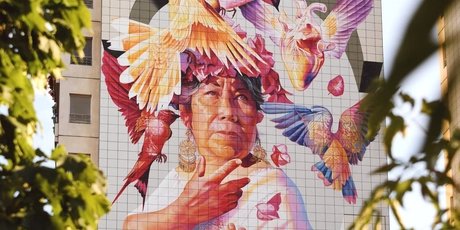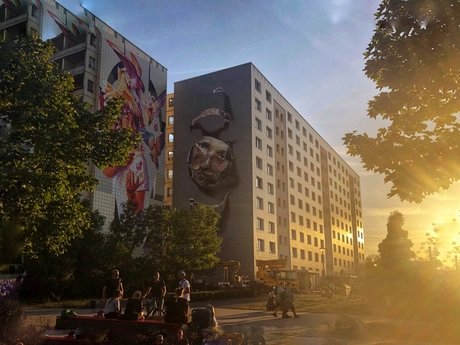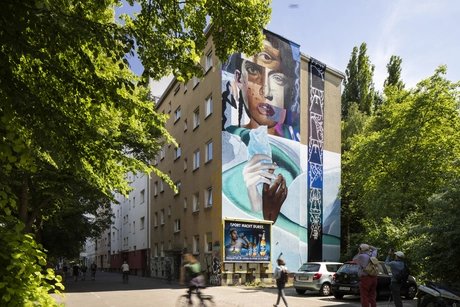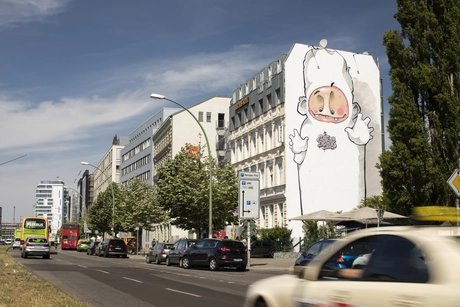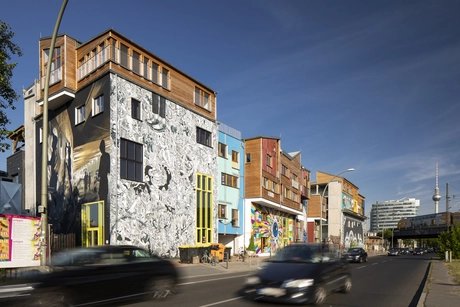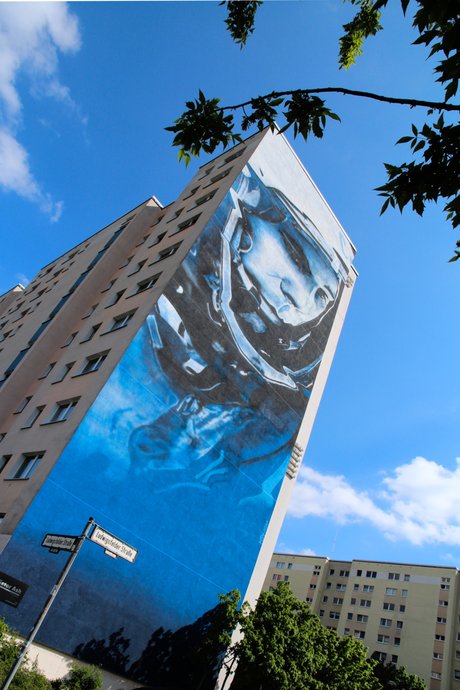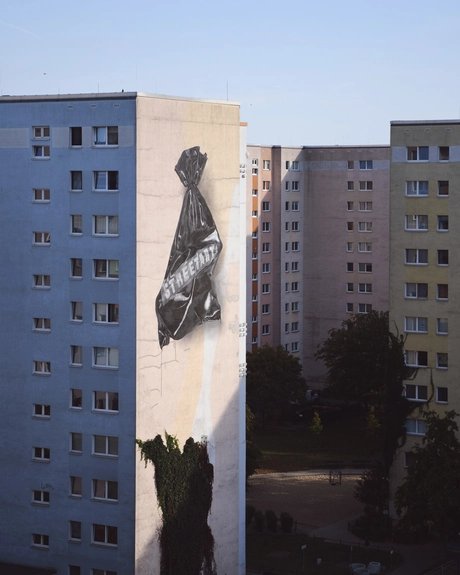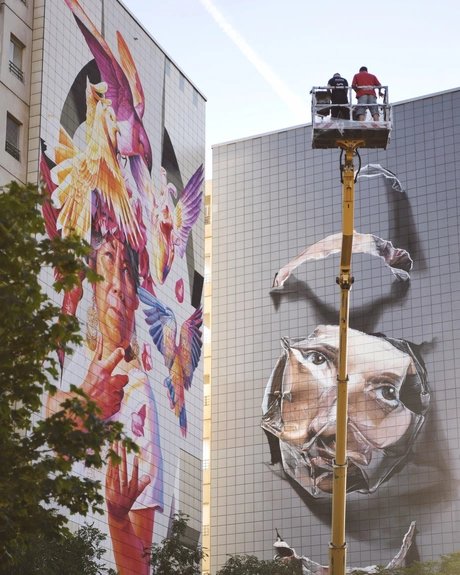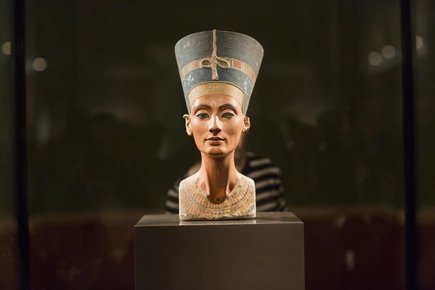
Colorful Walls: Murals in Marzahn-Hellersdorf
The end of the gray
In 2019, urban artists transformed the capital into a giant art gallery for the second time at the Berlin Mural Fest. With their huge murals, internationally renowned and Berlin-based urban artists decorate facades and house walls, many of those in the district of Marzahn-Hellersdorf, where mainly facades of GDR prefabricated buildings serve as urban canvases.
Triumph of urban art
The murals are as varied as the artists themselves: some cover the entire surface, others only part of it. Many are colorful and bring color to the streets, while some are strictly black and white. Comic style, stencil graffiti, text elements, abstract shapes, there are no limits to the imagination when it comes to Berlin murals.
Since the turn of the millennium, mural painting has started a triumphal procession around the world. In addition to street art à la Banksy, facade art has also become a global phenomenon. The most sought-after muralists receive commissions from all over to design public spaces with their unmistakable style. Gradually, more and more cities are celebrating urban art with official festivals, from Upfest in Bristol to the MURAL Festival in Montreal to the Berlin Mural Fest.
The end of the gray zone
The motto for Berlin Mural Fest 2019 is "the end of the gray zone," and that's no exaggeration: with their colorful murals, the participating urban street artists are changing Berlin's gray into gray and making the city a more colorful place. The walls of the capital's buildings offer perfect conditions to experiment with colors and shapes.
In its second edition, the Berlin Mural Fest brings some innovations: in addition to conquering new spaces in the outskirts of Berlin, the organizers are increasingly relying on digital technology to complement the murals.
An app for the BMF has been available since 2018, and since 2019 visitors have been able to bring the murals to life using an augmented reality function. In addition, users of the app can watch making-off videos to witness the creative process of the individual murals.
Tip: With our free ABOUT BERLIN app, you can go on a street art tour on your own. You can also find exciting background stories about the murals as well as the street artists who have immortalized themselves in Berlin.
Marzahn becomes colorful

- Spanish artist Okuda San Miguel's murals may be among the BMF's most colorful. His subjects are people, animals and mixed creatures, which he composes from rainbow-colored geometric surfaces. He describes his style as pop surrealism and draws inspiration from the art of different cultures. In terms of content, he wants to evoke the magic of animalistic ideas, the idea that animals and humans have a spiritual connection with each other. You can find his Berlin mural at 31 Murtzaner Ring in Marzahn.
- An internationally known artist with German roots has designed Alte Hellersdorfer Strasse 133. MadC, aka Claudia Walde, is originally from Bautzen and, like many other urban artists, had her beginnings as a sprayer. Although she has also sprayed photorealistically in the past, her more recent works are abstract. She is interested in transparency and layering of colors in her work. Most recently, she designed the interiors of a disused airport terminal in Dresden and a high-rise building in Jersey City.
- Just a few houses away, at Alte Hellersdorfer Strasse 129, the Dixons collaborated with 3D video artist extraweg. What makes it special is that extraweg is developing a digital and animated version of the Dixons' murals so that visitors can bring them to life via the BMF app.
Mexican motifs and photorealism in Märkische Allee
- Two urban artists are embellishing Märkische Allee at once. Mexican artist Adry del Rocio has designed house number 158, a prefab building covered in small square tiles. Del Rocio, who also creates award-winning 3D street paintings, often draws on motifs from her home country for her art. Portraits of women and men with Aztec-inspired headdresses, geckos, cactus flowers and ghostly made-up faces like those seen on Día de los Muertos.
- At 164 Märkische Allee, Akut, the male half of Herakut, a street art duo founded in 2004, immortalized himself. Together with Hera, Akut already participated in the BMF in 2018, creating a mural at Luckauer Straße 14. Typical components of their work are playful, photo-realistic motifs combined with text elements: last year's mural shows a girl in a bear hoodie, the windows of the facade have become part of a building block tower. Next to it the message: "My home might be no palace. But we can share it if you like".
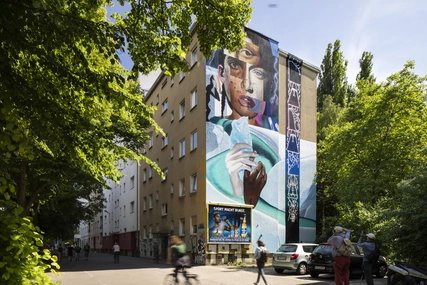
Old, New and Classic Motifs
- Also in Hellersdorf, at Ludwigsfelder Strasse 14, Frenchman Victor Ash a created another mural in Berlin. The artist already created one of Berlin's best-known murals in 2007: Astronaut/Cosmonaut at Oranienstrasse 195 has long since become a Kreuzberg landmark. Now a second Astronaut/Cosmonaut takes off in the east of the city. In the immediate neighborhood sprays Boogie, graffiti artist from Berlin. Boogie is primarily a writer, which means he creates lettering. He often immortalizes his name in ever new variations.
- More in the city center are the works of Aryz, Pichi Avo and Smug One. Spanish artist Aryz, whose trademark is the use of pastel colors, paints at Friedrichstrasse 9. In recent years, his paintings have been reminiscent of neorealist art with their monochromatic surfaces and depictions of human bodies. Working on the wall next to Aryz are Pichi Avo, two artists from Spain who have been spraying together since 2007. Their works combine graffiti tags with photorealistic classical motifs, such as Greek statues.
- Smug One, who is originally from Australia and now lives in Scotland, says his artistic evolution from tags to comic-style characters to photorealistic images came naturally. His paintings often feature people and animals in happy harmony: for example, in a mural in Glasgow, a robin has settled on a man's hand. His Berlin mural is being created at Manteuffelstrasse 70 in Kreuzberg.
History of the Berlin Mural Fest
- In 2018, street art group The Dixons hosted the Mural Fest in Berlin for the first time. Starting at the end of May 2018, urban artists transformed Berlin facades into giant works of art with the help of scaffolding, mobile lifting platforms and lots of paint. Most of these murals can be found in Kreuzberg, Friedrichshain and Moabit.

The artists of 2018 included firmly established greats of the Berlin street art scene. The Dixons took part themselves; at Mühlenstraße 6 near the Oberbaumbrücke, their mural features a comic-strip-style character. El Bocho, one of the capital's best-known street artists, designed a wall at Holzmarktstraße 25 with a recurring motif from his work: larger-than-life portraits that, according to their style, are reminiscent of Pop Art. El Bocho often depicts girls and women with wild, colorful hair gazing unblinkingly at the viewer, and Holzmarktstraße is no exception.
Let yourself be inspired: Our ABOUT BERLIN app
Where can you find the most beautiful murals in Berlin? What are the stories behind the murals? Which street artists were involved? And what messages do they want to convey with their works? You can find answers to these questions on our free ABOUT BERLIN app. In addition to several street art tours including directions, you will find videos and interpretive audio books. Let us explain the details of the murals and immerse yourself in Berlin's street art scene. Download now for free for iPhone and Android.


There are many stories to tell: ABOUT BERLIN.
